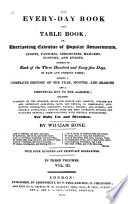 | Sir Richard Phillips - 1832 - 286 pages
...heat that fall upon them. Polished surfaces, espe* cially of metallic substances, reflect them. best. The angle of incidence is always equal to the angle of reflection. Observation. Hence, by means of concave reflectors, heat may be converged to a focus like light. Glass... | |
 | 1833 - 666 pages
...reflected light. Plato and his disciples taught, that light was emitted in straight lines, and proved that the angle of incidence is always equal to the angle of reflection. Plato has told us the same thing that Newton has told us; that colours are produced by light transmitted... | |
 | William Hone - 1835 - 924 pages
...of optics, by the important discovery they made, that light emits itself in straight lines, and that the angle of incidence is always equal to the angle of reflection. Plato terms colours " the effect of light transmitted from bodies, the small particles of which were... | |
 | Sir Daniel Keyte Sandford - 1837 - 528 pages
...object. The law of reflection, \ve have been considering, holds equally true if the mirror be curved, ie, the angle of incidence is always equal to the angle of reflection. Thus, in a concave mirror, AB, fig. 10, let ab, С de, f, be parallel r;iys from some distant object,... | |
 | Edward Turner - 1837 - 436 pages
...reflected rays always form equal angles with the reflecting surface ; or, what amounts to the same, the angle of incidence is always equal to the angle of reflection. Let AB, figure 1, represent a plane mirror, ID the direction of a ray falling on AB at the point D,... | |
 | William Hone - 1837 - 922 pages
...of optics, by the important discovery they made, that light emits itself in straight lines, and that the angle of incidence is always equal to the angle of reflection. Plato terms colours " the effect of light transmitted from bodies, the small particles of which were... | |
 | William Hone - 1838 - 890 pages
...of optics, by the important discovery they made, that light emits itself in straight lines, and that the angle of incidence is always equal to the angle of reflection. I'lato terms colours " the effect of light transmitted from bodies, the small particles of which were... | |
 | John Rowbotham - 1838 - 404 pages
...bending or throwing back the rays of light from a mirror u or from any polished surface, in which case, the angle of incidence is always equal to the angle of reflection. Reg'-i-cide, s. — rex, regis, a king- ; and ccedo, I kill. A murderer of a king ; the crime of killing... | |
 | 1839 - 272 pages
...scientific mode of expressing the direction in which the reflection will take place, by saying that the " angle of incidence is always equal to the angle of reflection," which in familiar language means, that however slanting the ball may approach the wall, it will rebound... | |
 | Mrs. Lincoln Phelps, Phelps (Mrs) - 1840 - 234 pages
...reflection ;t the more oblique is the line of incidence, the more so will be the line of reflection. The angle of incidence is always equal to the angle of reflection ; thus the angle abd, is equal to the angle abc, because the line, ab, divides the larger angle, c... | |
| |